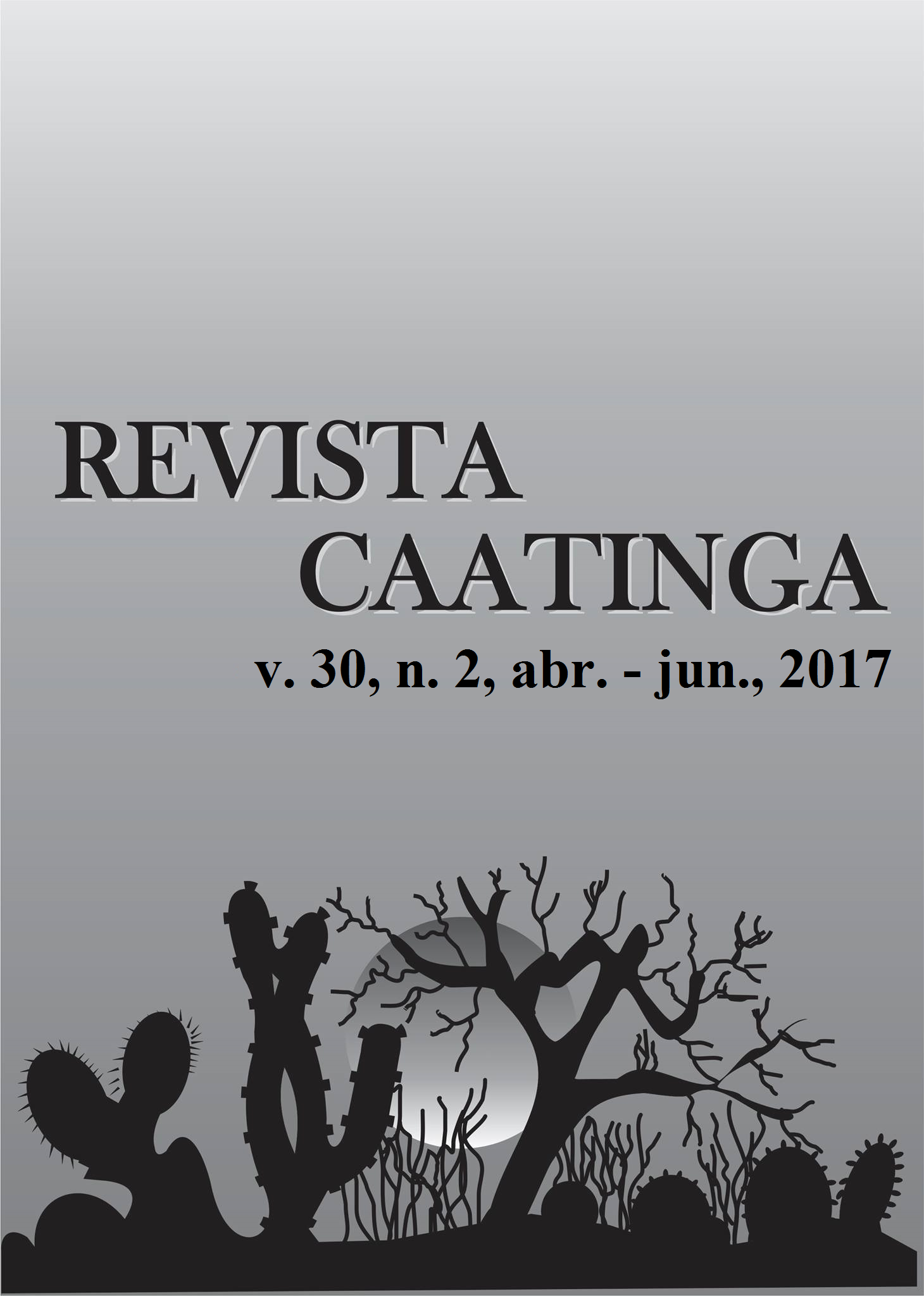DIFFERENT SHADING ENVIRONMENTS IMPACT GROWTH AND YIELD OF THREE MINI-TOMATO CULTIVARS
DOI:
https://doi.org/10.1590/1983-21252017v30n207rcKeywords:
Solanum lycopersicum. Shading screens. Growth analysis. Red Sugar. Sweet Million. Shani.Abstract
Our study was conducted in the experimental field of the Department of Technology and Social Sciences (DTCS) of the State University of Bahia - UNEB, Juazeiro-BA. The experimental design was comprised of randomized blocks, sub-subdivided in plots, with four replicates comprising the plots of three different shading methods, gray shading screen (GS), red shading screen (RS), and blue shading screen (BS), and the control treatment with no shading. The subplots comprised three mini-tomato cultivars (“Sweet Million”, “Red Sugar”, and “Shani”), and sub-subplots consisted of seven sampling times. The traits evaluated were: dry matter accumulation in leaves, stems, roots, and fruits, total dry matter, shoot length, root length, total number of fruits, and overall yield. The results of the growth analysis showed that dry matter accumulation in organs of mini tomatoes was similar in all treatments and that the highest total dry matter accumulation occurred under RS. In all treatments, fruit was the preferential drainage; however, the cultivar “Red Sugar” showed higher dry matter accumulation in other plant organs. “Red Sugar” also showed the highest number of fruits per plant; however, when we evaluated total productivity, “Sweet Million” and “Shani” showed similar, higher values than “Red Sugar”.Downloads
References
ALVARENGA, M. A. R. de. Tomate: produção em campo, em casa de vegetação e em hidroponia. 1. ed. Lavras, MG: EDITORA UFLA, 2004. p. 15-23.
AZEVEDO, V. F.; ABBOUD, A. C. S.; CARMO, M. G. F. Row spacing and pruning regimes on organically grown cherry tomato. Horticultura Brasileira, Brasília, v. 28, n. 4, p. 389-394. 2010.
BOAVENTURA. R. C. Viabilidade técnica do cultivo de tomate em estufa no distrito federal. 1. ed. Planaltina, DF: UPIS – Faculdades integradas, 2007. 63 p.
COSTA, N. D. et al. Tomate rasteiro irrigado. Recomendações de adubação para o estado de Pernambuco. 2. ed. Recife, PE: IPA – Instituto Agronômico de Pernambuco, 2008. 195 p.
EMPRESA BRASILEIRA DE PESQUISA AGROPECUÁRIA - EMBRAPA. Médias Anuais da Estação Agrometeorológica de Bebedouro. Disponível em: http://www.cpatsa.embrapa.br:8080/servicos/dadosmet/ceb-anual.html. Acesso em: 17 jan. 2013.
ENGEL, V. L.; POGGIANI, F. Estudo da concentração de clorofila nas folhas e seu espectro de absorção de luz em função do sombreamento em mudas de quatro espécies florestais nativas. Revista Brasileira de Fisiologia Vegetal, Londrina, v. 3, n. 1, p. 39-45, 1991.
FAYAD, J. A. et al. Crescimento e produção do tomateiro cultivado sob condições de campo e de ambiente protegido. Horticultura Brasileira, Brasília, v. 19, n. 3, p. 232-237. 2001.
FERREIRA, D. F. SISVAR Versão 5.3. Lavras: Departamento de Ciências Exatas, UFLA. 2010.
FILGUEIRA, F. A. R. Novo manual de olericultura: agrotecnologia moderna na produção e comercialização de hortaliças. 2. ed. rev. ampl.,Viçosa, MG: EDITORA UFV, 2000. 402 p.
FONTES, P. C. R. et al. Produção de Cultivares de Tomate em Estufa Coberta com Plástico. Revista Ceres, Viçosa, v. 44, n. 252, p. 152-160. 1997.
GUSMÃO M. T. A.; GUSMÃO S. A. L.; ARAÚJO J. A. C. Produtividade de tomate tipo cereja cultivado em ambiente protegido e em diferentes substratos. Horticultura Brasileira, Brasília, v. 24, n. 4, p. 431-436. 2006.
HEUVELINK, E. Growth, development and yield of a tomato crop: periodic destructive measurements in greenhouse. Scientia Horticulturae, Netherlands, v. 61, n. 1, p. 77-99, 1995.
HOLCMAN, E.; SENTELHAS, P. C.; MELLO, S. C. Alterações microclimáticas provocadas por diferentes coberturas plásticas em ambiente protegido cultivado com tomate tipo cereja no sudeste do Brasil. Revista Brasileira de Meteorologia, São Paulo, v. 30, n. 2, p. 125-133, 2015.
INSTITUTO BRASILEIRO DE GEOGRAFIA E ESTATÍSTICA - IBGE. Levantamento sistemático da produção agrícola. Rio de Janeiro, RJ, v. 26, n. 9, p. 1-84., 2013.
LOPES, W. A. R. et al. Análise do crescimento de tomate ‘SM-16’ cultivado sob diferentes coberturas de solo. Horticultura Brasileira, Brasília, v. 29, n. 4, p. 554-561. 2011.
ROCHA, R. C. Uso de diferentes telas de sombreamento no cultivo protegido de tomateiro. 2007. 90 f. Tese (Doutorado em Agronomia) – Universidade Estadual Paulista, Faculdade de Ciências Agronômicas, Botucatu, 2007.
SHAHAK, Y. Photo-selective netting for improved performance of horticultural crops. A review of ornamental and vegetable studies carried out in Israel. Acta Horticulture, Leuven, v. 797, n. 770, p. 75-80. 2008.
Downloads
Published
Issue
Section
License
Os Autores que publicam na Revista Caatinga concordam com os seguintes termos:
a) Os Autores mantêm os direitos autorais e concedem à revista o direito de primeira publicação, com o trabalho simultaneamente licenciado sob a Licença Creative Commons do tipo atribuição CC-BY, para todo o conteúdo do periódico, exceto onde estiver identificado, que permite o compartilhamento do trabalho com reconhecimento da autoria e publicação inicial nesta revista, sem fins comerciais.
b) Os Autores têm autorização para distribuição não-exclusiva da versão do trabalho publicada nesta revista (ex.: publicar em repositório institucional ou como capítulo de livro), com reconhecimento de autoria e publicação inicial nesta revista.
c) Os Autores têm permissão e são estimulados a publicar e distribuir seu trabalho online (ex.: em repositórios institucionais ou na sua página pessoal) a qualquer ponto antes ou durante o processo editorial, já que isso pode gerar alterações produtivas, bem como aumentar o impacto e a citação do trabalho publicado (Veja O Efeito do Acesso Livre).







